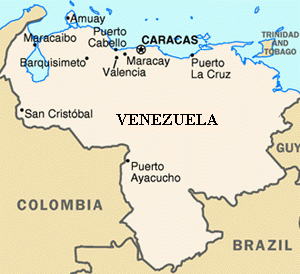 |
Venezuela
 U.S. Department of State Background Notes: Republic of Venezuela, September 1997 Released by the Bureau of Inter-American Affairs.
|
|
Official Name: Republic of Venezuela
GEOGRAPHY
Area: 912,050 sq. km. (352,143 sq. mi.); about the size of Texas and Oklahoma
combined. PEOPLE
Nationality: Noun and adjective--Venezuelan(s). GOVERNMENT
Type: Federal republic. ECONOMY
GDP (1996 est.): $65 billion. U.S.-VENEZUELAN RELATIONS U.S. relations with Venezuela are close. The two countries share a strong mutual commitment to democracy. As the U.S. number-one supplier of foreign oil, Venezuelan commercial ties are close. Major U.S. interests in Venezuela include protection and promotion of U.S. exports and investment; continuation of the economic reform program; preservation of constitutional democracy; closer counternarcotics cooperation; and maintaining access to a leading source of foreign petroleum. The United States is Venezuela's most important trading partner, representing approximately half of both imports and exports. In turn, Venezuela is the U.S. third-largest export market in Latin America, purchasing U.S. machinery, transportation equipment, agricultural commodities, and auto parts. Venezuela's opening of its petroleum sector to foreign investment in 1996 created tremendous trade and investment opportunities for U.S. companies. The Department of State is committed to promoting the interests of U.S. companies in overseas markets. Contact information and a list of government publications can be found in the section "Other U.S. Government Contacts" toward the end of this document. Venezuela is a minor source country for opium poppy and coca, but a major transit country for cocaine and heroin. Money laundering and judicial corruption are major concerns. The United States is working with Venezuela to combat drug trafficking. In FY1997, the United States allocated $600,000 for counternarcotics assistance and about $350,000 through the International Military Education and Training (IMET) program. In addition, the United States plans to deliver excess U.S. military equipment worth $12.25 million to the Venezuelan armed forces for counternarcotics use. There is no U.S. Agency for International Development (USAID) or Peace Corps mission in Venezuela. Approximately 23,000 U.S. citizens living in Venezuela have registered with the U.S. embassy, an estimated three-quarters of them residing in the Caracas area. An estimated 12,000 U.S. tourists visit Venezuela annually. About 500 U.S. companies are represented in the country. PEOPLE AND HISTORY
Most Venezuelans are of European, indigenous, and/or African descent. About 85% of the population lives in urban areas in the northern portion of the country. While almost half of Venezuela's land area lies south of the Orinoco River, this region contains only 5% of the population. The indigenous peoples ranged from agriculturists to less advanced groups living on islands offshore. The first permanent Spanish settlement in South America--Nuevo Toledo--was established in Venezuela in 1522. However, Venezuela was a relatively neglected colony in the 1500s and 1600s as the Spaniards focused on extracting gold from other areas of their empire in the Americas. The Venezuelans began to grow restive under colonial control toward the end of the 18th century. After several unsuccessful uprisings, the country achieved independence from Spain in 1821 under the leadership of its most famous son, Simon Bolivar. Venezuela, along with what are now Colombia, Panama, and Ecuador, was part of the Republic of Gran Colombia until 1830, when it separated and became a sovereign country. Much of Venezuela's 19th century history was characterized by periods of political instability, dictatorial rule, and revolutionary turbulence. The first half of the 20th century was marked by periods of authoritarianism--including dictatorships from 1908-1935 and from 1950-1958. The Venezuelan economy shifted from a primarily agricultural orientation to one centered on petroleum production and export after the First World War. Since the overthrow of Gen. Marcos Perez Jimenez in 1958, Venezuela has enjoyed an unbroken tradition of civilian democratic rule marked by the military's withdrawal from direct involvement in national politics. Until 1993, when Rafael Caldera won the presidential election on a coalition "Convergence" ticket, the presidency had passed back and forth between the country's main political parties, Accion Democratica (AD) and the Christian Democratic (COPEI) Party. ADDITIONAL INFORMATION
For more information, visit the
State Department's home page. |
|
President Clinton's Trip to Venezuela, Brazil and Argentina